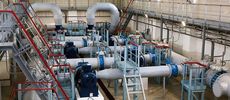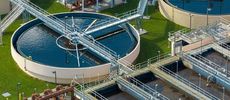New Wastewater Management Tools for Lagoons


More than 3,000 years ago, a Bronze Age wastewater manager dumped sewage into a pond—and found given time, the resulting effluent was surprisingly clean. Millennia later, San Antonio became the site of the first man-made treatment lagoon in the United States. Today, more than 8,000 wastewater management lagoons operate across the country, primarily in smaller, rural, and Tribal communities.
These systems often lack the financial and technical resources necessary to comply with Clean Water Act provisions. So in September 2024, the Environmental Protection Agency (EPA) released a number of tools for lagoon wastewater management to support public and environmental health. The new tools are intended to help decision-makers effectively and efficiently protect people and the environment, handle compliance challenges, and improve asset management planning.
Here's a look at the benefits of wastewater management lagoons, the challenges managers face, the new EPA resources that can help communities tackle issues, and the role water test labs play.
Lagoons Provide Efficient, Low-Maintenance Wastewater Treatment
Wastewater management lagoons consist of ponds or basins that use natural and biochemical processes to treat wastewater. The ponds are constructed and lined with materials, such as clay or impermeable liners, that prevent seepage into groundwater. Compared to other wastewater treatment options lagoons are generally more efficient and require less maintenance, saving communities money.
You can think of lagoons as the counterparts of the holding tanks in more sophisticated systems. Sewage flows into a pond, where beneficial bacteria and other organisms break down organic compounds. A series of lagoons handles anaerobic, aerobic, and combined treatment. These ponds remove nutrients such as nitrogen and phosphorus, helping to reduce biological oxygen demand. At the same time, they digest solids by allowing nature to work over time. But it's not all natural—proper performance depends on continual maintenance and upkeep.
Lagoon Managers Face Compliance and Cost Challenges
Lagoon wastewater treatment systems face several challenges that can make producing effluent clean enough to discharge into waterways tough for the communities that use them.
- Sludge: Lagoons naturally digest sludge given enough time. Excessive loads mean sludge accumulates in the pond, filling it up and requiring costly dredging and removal. Also, restricted flow can create dead spots that limit system capacity.
- Fat, oil, and grease: Without proper treatment, fat, oil, and grease (FOG) can solidify on the water surface, resulting in a high price for removal. FOG can also block equipment and slow down aeration, leading to odor and hydrogen sulfide, that undesirable rotten egg smell.
- Odor: Microbes that digest organic material release volatile fatty acid compounds, which smell as unsavory as they sound. Community complaints can mean expensive fines, lawsuits, and loss of tourism.
- Hydrogen sulfide: This repulsive smell is toxic to people and corrosive to equipment and infrastructure, increasing the potential for lawsuits and hefty fines.
Communities that rely on lagoons must meet evolving regulatory requirements that mean more complex and costly wastewater treatment technology. They need greater financial and technical capacity to identify the technology or process improvements that will serve them best at the most affordable cost.
New Tools Enhance Operations and Management
The Lagoon Wastewater Treatment Action Plan helps communities identify alternative and retrofit technologies, and provides other assistance to support equity and sustain clean waterways. As part of the plan, the EPA developed several tools:
- First Stop Toolbox for Lagoons identifies technical, financial, and regulatory support resources in an intuitive web tool that helps lagoon operators and technical assistance providers assess operations and compliance challenges, and it aids communities in resolving those challenges.
- Ammonia Water Quality Standards (WQS) Variance Tools for Small Communities with Lagoon Wastewater Treatment Systems combines the "Small Lagoon Communities Economic Streamlining Tool" and the "Individual Lagoon Tool." These help lagoon operators determine whether a WQS variance makes sense for a small community experiencing compliance challenges related to ammonia.
- Troubleshooting Manual for Small Wastewater Lagoon Systems helps operators diagnose and troubleshoot causes of system noncompliance, optimize performance, and comply with their National Pollutant Discharge Elimination System permit.
- Understanding Lagoon Requirements Under 40 C.F.F. Part 503: Best Management Practices for Use or Disposal of Sewage Sludge, Part 1. This document explains rules related to land application of sewage sludge removed from lagoons.
Water testing is critical to ensure the efficiency and lower cost of lagoon wastewater treatment don't compromise the quality of the water discharged. At every step of lagoon treatment, water test labs can help operators comply with standards and protect the environment their communities depend on for water.






